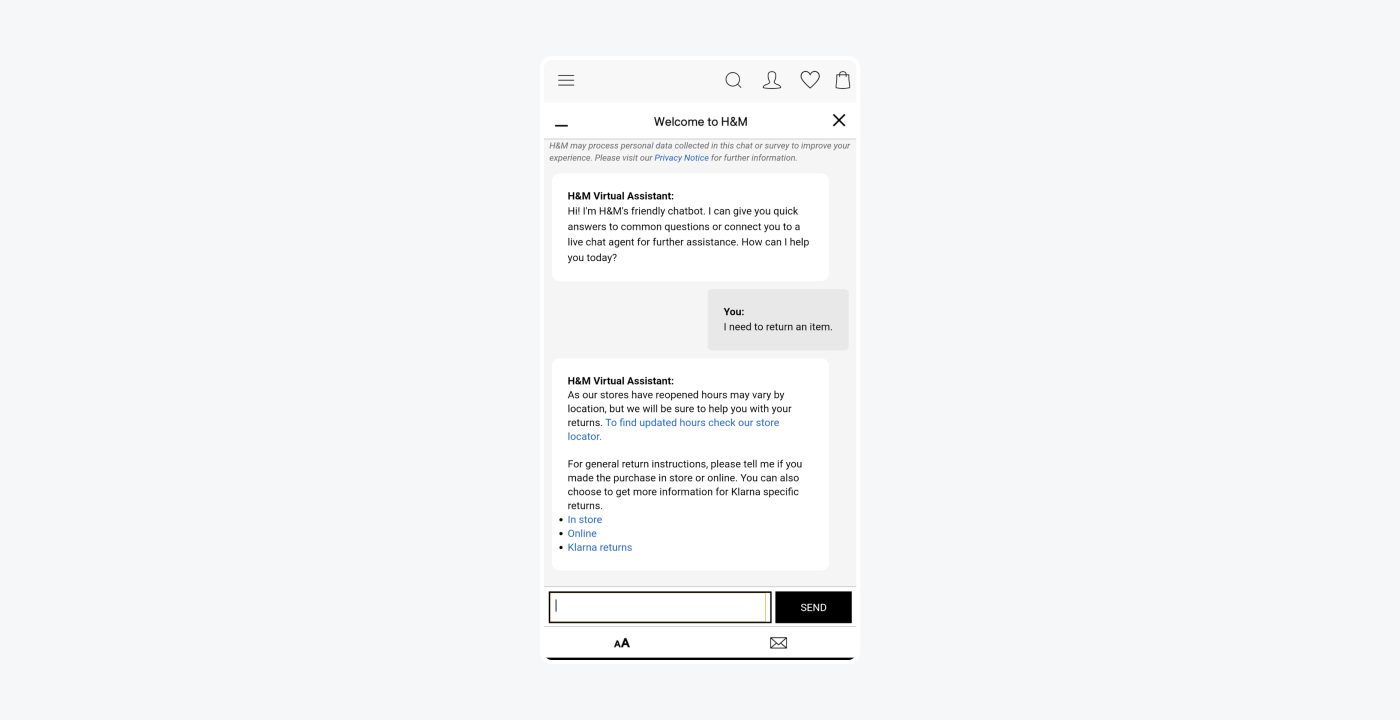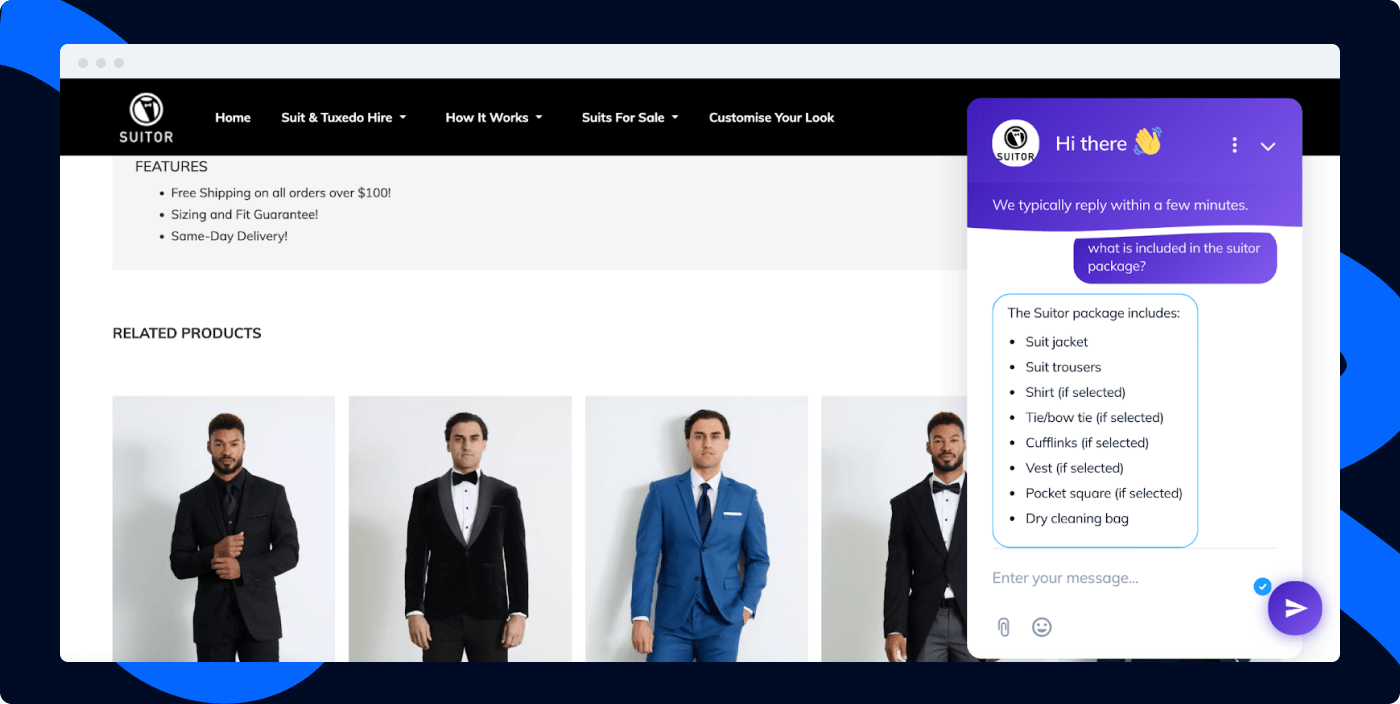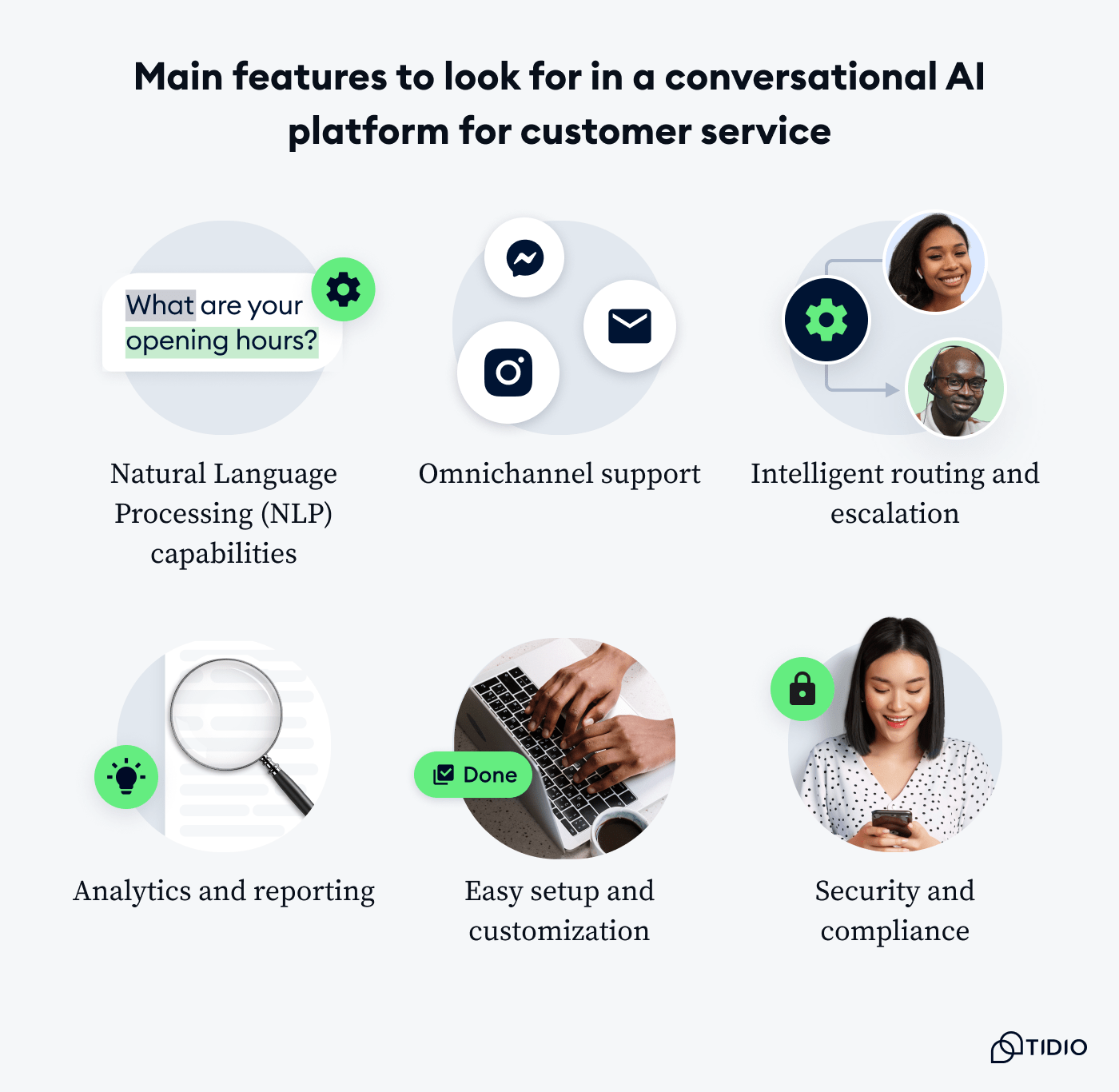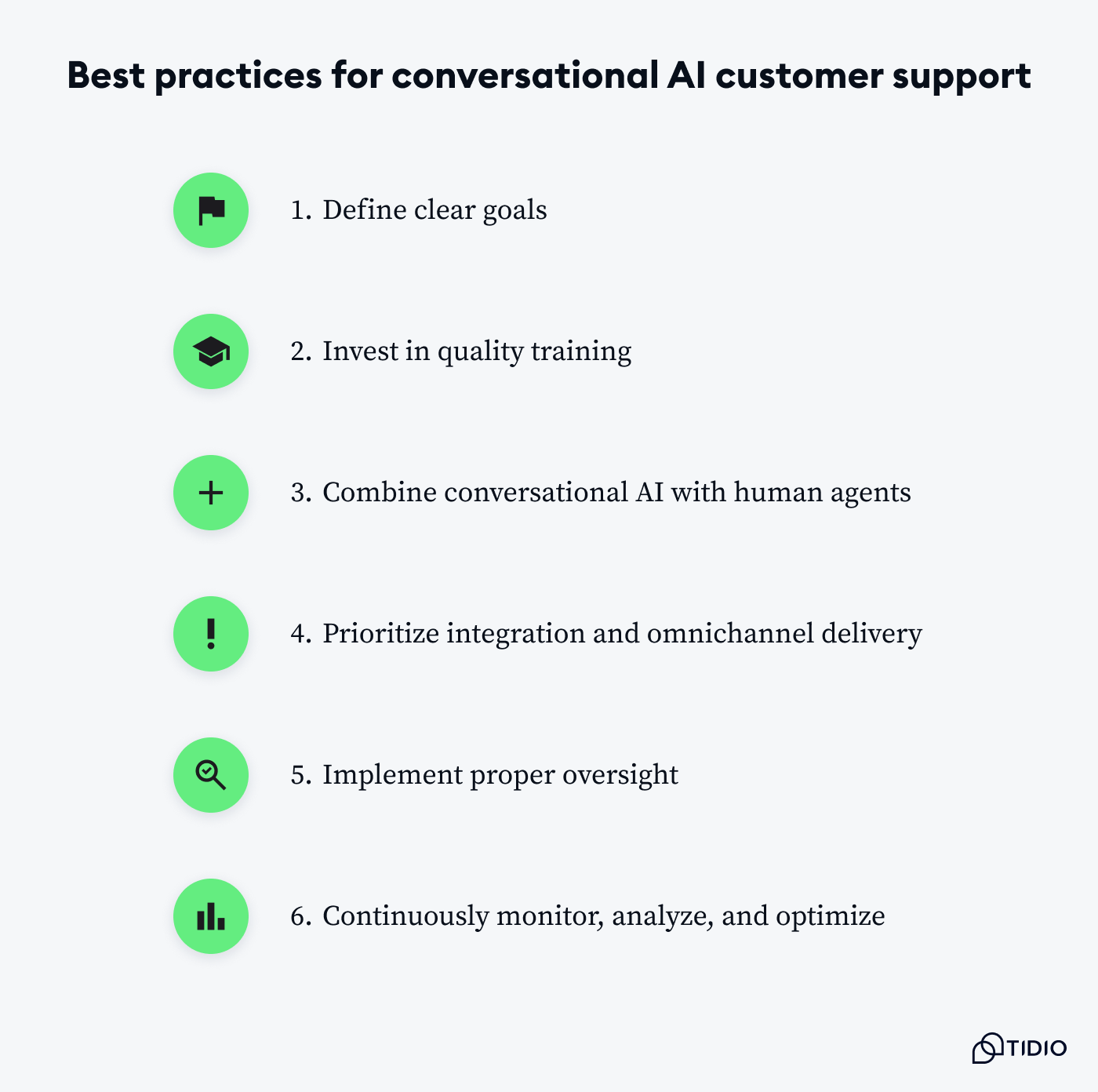Having a conversation with a support representative provides a much better feeling than clicking around the predefined questions that don’t match the intent. Or even better than waiting up to 5 business days for an email back.
That’s why many businesses nowadays use conversational AI for customer service.
But what is it and how to utilize it effectively?
That’s what we’re here to discuss.
In this article:
- What conversational AI customer service is
- How does this technology work
- Most frequent use cases of conversational service
- Benefits of conversational customer support
- Main features you should look out for
- Tips and best practices for effective implementation
Start using conversational AI today and enhance your customer service
Want to learn more about the topic of AI in customer service? Check these out:
- What Is Conversational AI & How It Works? [Guide]
- Chatbots vs. Conversational AI: Is There Any Difference?
- 22 Best AI Chatbots [ChatGPT & Alternatives]
First things first—
What is conversational AI in customer service?
A conversational AI for customer service leverages natural language processing (NLP) and machine learning (ML), to communicate with customers in a human-like manner via chatbots or virtual assistants. It’s designed to understand and interpret users’ inquiries expressed in human language, whether through text or voice input, and provide relevant and contextual responses.

Conversational AI customer service systems are typically powered by machine learning algorithms trained on vast amounts of data, including chat transcripts of past interactions, knowledge bases, and other relevant information. This training enables the AI technology to understand the context and intent behind client inquiries and provide appropriate responses.
AI customer support software can be deployed across various channels, such as websites, mobile apps, messaging platforms, or voice assistants. This way, the technology can offer a consistent and seamless customer experience regardless of the communication channel.
By leveraging conversational customer experience, businesses can reduce wait times, improve user satisfaction, and potentially lower operational costs associated with traditional customer service methods.
Conversational AI appears in various customer service touchpoints, primarily aimed at enhancing self-service experiences. Some key examples include:
- AI-powered chatbots—they provide a natural conversational experience when handling inquiries
- Interactive Voice Response (IVR) systems—they leverage automatic speech recognition, natural language processing, and machine learning to deliver voice-based support
- AI knowledge base—provides relevant resources to user questions streamlining information retrieval
In essence, conversational AI aims to provide more intelligent, natural language-based interactions across various customer service channels, enhancing client self-service capabilities and delivering a smoother overall experience.
How does conversational AI for customer support work?
Conversational AI for customer support leverages several key technologies and techniques:

- Natural Language Processing (NLP)—the algorithms are used to analyze and understand the customer’s input, whether in text or speech form
- Natural Language Understanding (NLU)—builds upon NLP to further comprehend the customer’s intent, sentiment, and the nuances of their language
- Machine Learning (ML)—the model learns patterns and relationships from the provided data, enabling it to generate relevant and contextual responses
- Dialog Management—determines the appropriate response or action based on the current conversation context and the AI’s understanding of the customer’s input
- Response Generation—once the system has interpreted the customer’s input and determined the appropriate response, it generates a natural language output
The combination of these technologies and techniques allows conversational AI for customer support to understand inquiries, provide relevant and personalized responses, and even complete tasks or transactions, all through natural language interactions.
Now, let’s have a look at some real-life examples of this system at work.
Conversational AI for customer service: use cases
Conversational AI technologies can be used to understand customer needs and serve them automatically across many sectors. These include ecommerce, financial services, and more.
Here are some common use cases of conversational AI in customer service:
Answering FAQs
One of the most widespread applications of conversational AI is in the form of chatbots. The AI-powered virtual assistants can handle a wide range of inquiries. These include answering frequently asked questions, providing product information, troubleshooting issues, and even processing simple transactions or requests.
An eyewear company, eye-oo uses chatbots to decrease the average response time and reduce the number of frequently asked questions going to the support agents. At the same time, the brand also utilizes bots to collect leads and improve overall customer satisfaction.

Read more: Discover how eye-oo boosted sales using Tidio’s conversational AI, Lyro. Also, learn about FAQ chatbots with types, benefits, and use cases explained.
Personalized product recommendations
By understanding customers’ preferences, purchase history, and conversational context, the AI agent can provide personalized product recommendations tailored to individual customers, improving the shopping experience and potentially increasing sales.
To provide customers with convenient and always-available support, H&M launched the H&M Virtual Assistant chatbot. This chatbot acts as a personalized shopping companion, offering sizing recommendations and tailored outfit ideas. Additionally, it’s designed to efficiently handle customer inquiries related to returns, store locations, and operating hours.

Read more: Learn about virtual shopping assistants, how they work, and real-life examples. Also, discover what a retail chatbot is with examples, benefits, and tips on how to use it effectively.
Customer onboarding and support
Conversational AI can assist in guiding new customers through the onboarding process, explaining products or services, and providing personalized support and troubleshooting. This can improve customer satisfaction and reduce the burden on human support staff.
Suitor, an Australian company specializing in suit and tuxedo rentals, has implemented this technology to provide round-the-clock customer service. The business leverages AI-powered chatbots to automate support processes, including answering common inquiries, triaging tickets, and handling other tasks.

Read more: Learn how Suitor automated over 85% of its customer service using Lyro.
Feedback collection
Conversational AI can analyze user interactions for sentiment, emotion, and feedback. This helps businesses understand client satisfaction levels, identify pain points, and make improvements to products or services based on real-time customer feedback.
Uber has fostered a culture of mutual feedback, where both riders and drivers have the opportunity to rate their experience after each trip. This two-way rating system empowers customers while simultaneously protecting the company’s employees. This system allows Uber to promptly identify and address any problematic drivers, ensuring a high-quality service for all users.

These use cases demonstrate how this technology can enhance customer service by providing more efficient, personalized, and intelligent interactions across various channels, ultimately improving the overall client experience.
With that out of the way, let’s look at answering a question—how does conversational AI improve customer experience?
Benefits of conversational support
AI customer support can help you streamline customer service processes and automate workflows. Of course, human conversations are important for effective customer engagement. However, AI technology can chat with your visitors when your human agents aren’t available, save you costs, and improve the overall shopping experience for your customers.
Here are 5 key benefits of using conversational AI for customer service:

24/7 availability
Conversational AI assistants can provide around-the-clock support, instantly responding to customer inquiries without the need for human agents. This improves responsiveness and ensures customers can get assistance whenever they need it. In fact, about 64% of consumers expect real-time responses from businesses.
Improved customer experience
This technology can understand natural language inputs and provide human-like, contextualized responses. This creates a more engaging and personalized experience for customers, improving their overall satisfaction with the service—research shows that 69% of consumers prefer chatbots for quick communication with brands.
Improve your customer experience using conversational AI
Cost savings
Implementing chatbots can reduce the need for customer service teams to handle routine or frequently asked questions. This, in turn, leads to significant cost savings for businesses by optimizing their customer service operations. Interestingly, a study shows that businesses can save up to 30% on customer support costs by implementing conversational AI.
Scalability and consistency
Unlike human agents, conversational AI systems can handle multiple customer interactions simultaneously without compromising quality or consistency. This scalability allows businesses to effectively manage high volumes of customer inquiries.
Data-driven insights
Conversational AI systems can capture and analyze customers’ interactions, providing valuable data-driven insights into user behavior, preferences, and pain points. This information can be used to improve products, services, and overall shopping experiences.
In short, conversational AI in customer service offers a variety of benefits, making it an attractive solution for businesses seeking to enhance their customer support operations.
With the benefits out of the way, let’s have a look at the key features you should keep an eye out for.
Main features to look for in a conversational AI platform for customer service
The main functionality of an AI co-pilot is answering customer questions effectively. Some of the other popular features include a proactive live chat, an AI help desk, a multilingual capability, and good support from the platform’s provider.
Of course, your business needs will determine what you’ll focus on looking for. But when evaluating conversational AI customer service software, there are several key features that you should keep in mind:

- Natural Language Processing (NLP) capabilities—the software should have robust NLP capabilities to accurately understand and interpret customer queries in natural language, regardless of phrasing or context
- Omnichannel support—for software that can seamlessly integrate with multiple channels, such as websites, mobile apps, messaging platforms, or social media apps
- Intelligent routing and escalation—the system should have the ability to intelligently route complex or unresolved queries to human agents when necessary, ensuring a seamless ticket escalation and continuity of the conversation
- Analytics and reporting—look for robust analytics and reporting capabilities that provide insights into customer interactions to help you keep an eye on the data and continuously improve client service
- Easy setup and customization—the software should offer a user-friendly interface for configuring and customizing conversational AI customer service
- Security and compliance—evaluate the software’s security measures, customer data privacy policies, and compliance with relevant industry regulations, especially if handling sensitive customer information
By considering these key features, you can select a conversational customer service software that meets your specific needs and helps you deliver an exceptional user experience.
Best practices for implementing conversational AI in your CS
Using a conversational AI platform for customer service is not a set-it-and-forget-it kind of job. You need to have a clear process, an understanding of your needs, and continuous monitoring of the system.
Here are 5 best practices for effectively implementing conversational AI into customer service operations:

1. Define clear goals
Start by clearly defining the specific use cases and goals for implementing conversational AI in customer service. This could include objectives like reducing response times, handling routine inquiries, improving self-service capabilities, or enhancing the overall customer experience. Having clear goals will help you to guide the implementation and measure success.
2. Invest in quality training
The performance of conversational AI heavily depends on the quality of the training data it receives. Ensure that you train the AI on a diverse set of real customer interactions, including queries, responses, and contextual data. Continuously update and refine the training data to improve the AI’s accuracy and understanding over time.
Read more: Learn how to easily train Tidio’s conversational AI, Lyro, and use it to scale your customer service.
3. Combine conversational AI with human agents
While chatbots can handle many customer service interactions efficiently, it’s crucial to strike the right balance by combining AI capabilities with human support teams. A well-designed customer service strategy should leverage the strengths of both AI and human support.
AI agents excel at handling routine, high-volume inquiries, providing quick responses, and offering self-service options. However, for more complex or sensitive issues that require empathy, emotional intelligence, or subjective judgment, human agents remain invaluable.
Read more: Check how companies using AI for customer service do it effectively.
4. Prioritize integration and omnichannel delivery
Conversational AI tools should be seamlessly integrated with existing customer service channels and backend systems. This integration enables the AI to access relevant information and provide personalized, context-aware responses. Additionally, aim for an omnichannel delivery approach, allowing customers to engage with the AI across multiple touchpoints like your website, mobile app, and messaging platforms.
Read more: Learn about omnichannel customer service with tips and best practices.
5. Implement proper oversight
Establish clear governance and oversight workflows to ensure the chatbots adhere to ethical guidelines, data privacy regulations, and brand standards. This may involve human oversight, regular audits, and mechanisms for customers to provide feedback or escalate issues to human agents when needed.
6. Continuously monitor, analyze, and optimize
Regularly monitor and analyze the performance of the system, including customer service metrics like client satisfaction, resolution rates, and conversation logs. Use these insights to identify areas for improvement, refine the AI’s knowledge base, and optimize the overall customer experience. Continuously update and retrain the AI with new data and feedback to ensure it remains relevant and effective.
By following these best practices, businesses can effectively implement conversational AI into their customer service operations. This will help them to deliver more efficient and personalized support while driving operational improvements and enhancing the overall customer experience.
Conversational AI customer service: summary
Conversational AI presents a powerful solution for enhancing customer service operations, delivering efficient, personalized, and seamless experiences across multiple touchpoints.
Conversational AI can understand inquiries, provide relevant responses, and complete simple tasks by leveraging natural language processing, machine learning, and intelligent dialog management. When combined with human agents’ expertise and emotional intelligence, this technology can revolutionize customer service. It can also drive operational efficiencies, improve client satisfaction, and foster long-lasting brand loyalty.
However, successful implementation requires a strategic approach. This includes defining clear use cases, integrating with existing systems, and ensuring robust data privacy as well as security measures.
As AI continues to advance, forward-thinking businesses that embrace conversational AI will gain a competitive edge in delivering exceptional customer experiences.
Don’t get left behind.
Use the best conversational AI for customer service available online

